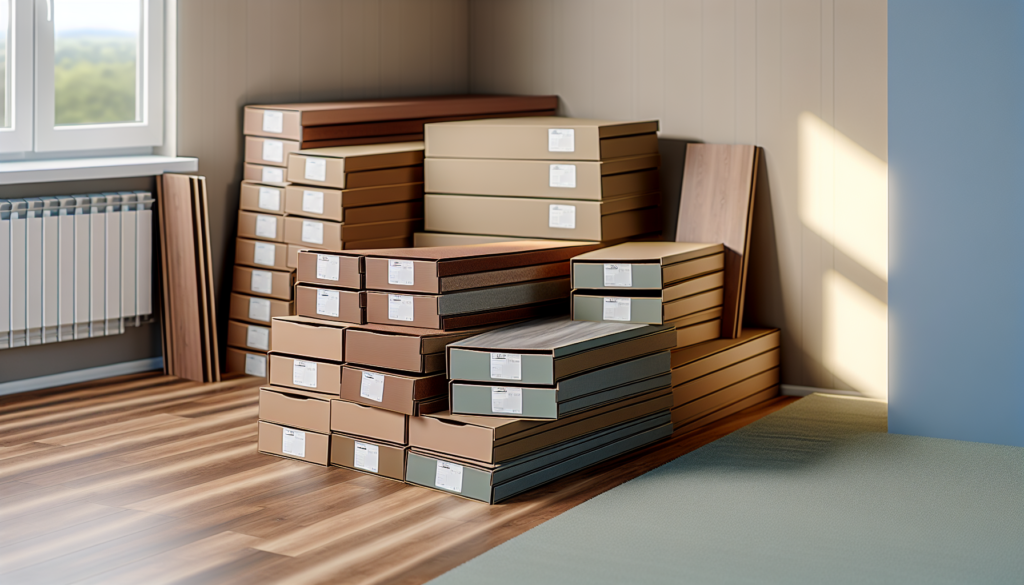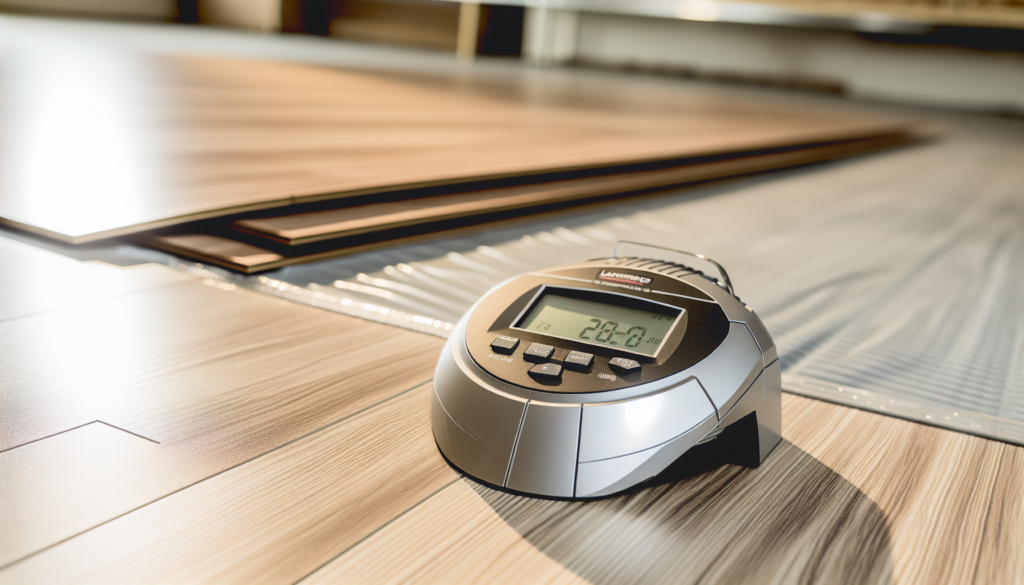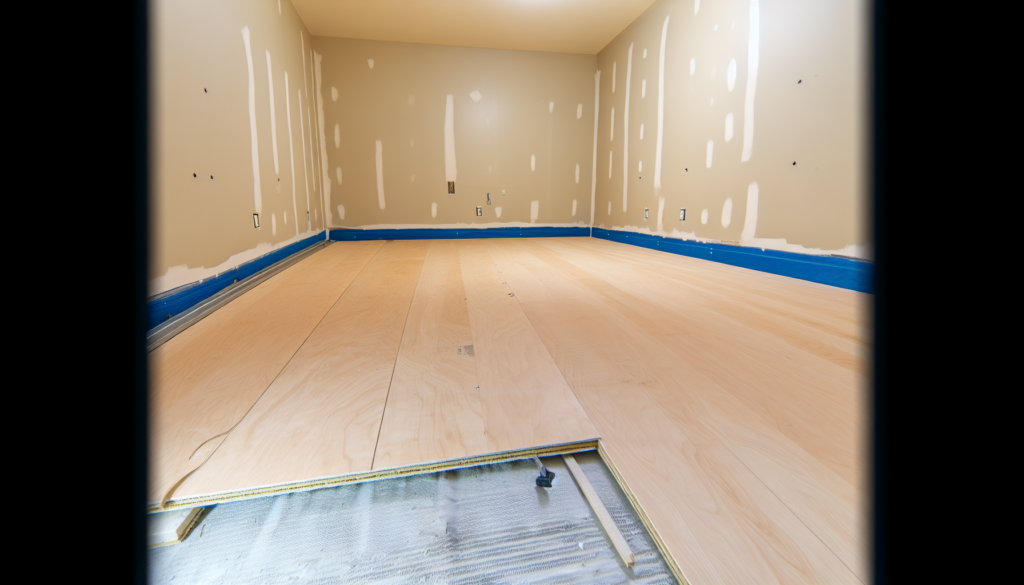Acclimating laminate flooring is a crucial step in your installation process, ensuring your new floor remains free of defects such as warping or buckling.
This guide provides a straightforward method on how to acclimate laminate flooring, helping you prepare for a successful installation.
You’ll learn exactly what needs to be done in a way that’s easy to understand and apply.
Key Takeaways
- Acclimating laminate flooring is critical to prevent warping, bending, and damage to locking mechanisms, requiring at least 48-72 hours of adjustment to the room’s temperature and humidity levels before installation.
- Properly reading and adhering to manufacturer instructions for acclimation, subfloor preparation, and installation methods is essential for ensuring the durability and visual appeal of the laminate flooring.
- Proper acclimation involves monitoring and maintaining room temperature between 64-86 degrees Fahrenheit and humidity levels between 30% to 60%, as well as making necessary adjustments to these conditions during the typical 48-72 hour acclimation period.
Importance of Acclimating Laminate Flooring

Proper acclimation of laminate flooring is crucial for the success of its installation.
This step allows the flooring to adapt to the room’s specific environmental conditions, which is particularly important as laminate can be sensitive to changes in temperature and humidity.
If your laminate flooring has not been properly acclimated, it may experience issues such as bending, warping or twisting.
These problems could even cause damage to the locking mechanisms and result in costly repairs or a need for complete re-installation.
It cannot be stressed enough that proper acclimation of your laminate flooring should not just be recommended but seen as essential.
Temperature and humidity are significant factors when considering how well laminated floors adjust during their installation process.
Neglecting this vital aspect can lead to unsatisfactory results with potential long-term consequences on both time and resources spent on correcting them.
Laminate Flooring’s Sensitivity to Environmental Conditions
Just like hardwood floors, laminate flooring also responds to changes in temperature by expanding and contracting.
Its sensitivity goes beyond just temperature – it is also affected by humidity due to the presence of wood-based layers, specifically engineered wood.
When exposed to high levels of humidity, the wood fibers within laminate flooring absorb moisture from their surroundings, which causes them to expand.
In contrast, when there is low humidity present, the moisture within the planks evaporates leading to shrinkage.
These changes in dimensions can cause issues such as unwanted gaps or warping in your laminated floorboards.
The Role of Acclimation in Preventing Installation Issues
Acclimation is a crucial step in the process of installing laminate flooring.
It not only helps prepare for the installation, but it also prevents potential issues such as warping, cracking, and difficulties with fitting the planks together.
This is achieved by ensuring that all laminate planks are exposed to consistent levels of temperature and humidity.
Proper acclimation significantly reduces the chances of problems like warping, cracking or buckling occurring after installation.
It makes future removal easier if needed.
By acclimating your laminate flooring to its surroundings before installation, you allow it time to adapt to room conditions which can help prevent gaps from forming between planks once they have been installed.
Step-by-Step Guide to Acclimating Laminate Flooring

After emphasizing the importance of acclimation, it is crucial to understand the process of preparing your laminate flooring.
Despite its seeming complexity, following these steps diligently will make it a straightforward task.
Before installation, laminate flooring usually requires acclimation, which involves three simple steps: stacking packaged boxes in their designated room and leaving them for 48-72 hours depending on temperature and humidity levels.
To ensure proper preparation before installation, do not skip out on allowing enough time (around 2-3 days) for the stacks of boxed laminates to adjust accordingly with regards to heat and moisture within that particular room.
Reading and Following Manufacturer Instructions
It is crucial to carefully follow the manufacturer’s instructions during the acclimatation process of laminate flooring.
These instructions may differ and provide specific guidance on installation methods, acclimation requirements, subfloor preparation, and maintenance recommendations.
Many people wonder if different brands of laminate flooring vary in terms of their features and benefits.
Each brand uses a unique fiberboard core for its boards, which allows them to cater to various needs when it comes to choosing the right option for your home.
It is also important to know how to properly remove old or damaged laminate flooring when considering updates or replacements.
Following these guidelines from manufacturers ensures that your new laminate floor adjusts appropriately with regards to temperature and humidity in its designated area.
This guarantees proper fitting as well as long-term preservation of appearance.
Preparing the Installation Space
Proper preparation of the installation area is crucial for successfully acclimating laminate flooring.
The ideal temperature range for this process is 64 to 86 degrees Fahrenheit (18 to 30 degrees Celsius), and it’s recommended to proceed with installing when humidity levels are between 30% and 60%.
Aside from regulating temperature and humidity, it’s essential to check the moisture content in the subfloor using a concrete moisture meter.
This ensures that it meets the acceptable level set by manufacturers for your specific type of laminate flooring before proceeding with its installation.
Storing and Arranging Laminate Flooring Boxes
The proper storage and arrangement of laminate flooring boxes is crucial for the acclimation process.
It is recommended to keep them in a horizontal position inside the house for at least one to three days before installation, allowing adequate air circulation and preventing potential damage.
Different types of laminate flooring may require specific storage methods.
Some panels are more vulnerable to warping or harm if not stored flat and horizontally, especially after being exposed to extreme conditions during shipping.
It’s essential to store these boxes away from exterior walls and ensure that they remain sealed until ready for use.
Monitoring and Adjusting Acclimation Conditions

To following the manufacturer’s guidelines and properly storing laminate flooring, it is essential to continuously monitor and adjust the acclimation process.
This ensures that your laminate flooring adjusts effectively.
The recommended temperature range for acclimating laminate floors is between 64-86 degrees Fahrenheit (18-30 degrees Celsius), while humidity levels should be maintained at 30%-60%.
Maintaining these conditions helps facilitate the adaptation of your floorings in their new environment, reducing potential problems after installation due to fluctuations in temperature or humidity.
Measuring Temperature and Humidity Levels
It is crucial to measure the temperature and humidity levels of a room in order to properly monitor the acclimation process.
A thermometer can be utilized for measuring temperature, while a hygrometer is used for monitoring humidity.
These tools are essential for maintaining recommended ranges of both temperature and humidity during the acclimation period for laminate flooring.
By doing so, one can ensure that the flooring adjusts effectively, which enhances its stability and durability post-installation.
Making Necessary Adjustments
Merely monitoring the temperature and humidity levels is not sufficient.
Adequate adjustments must be made in order to maintain these conditions within the recommended ranges.
Failing to make necessary changes can result in fluctuations of temperatures, which may cause laminate flooring to expand or shrink excessively.
This can lead to dimensional distortion and structural damage.
Regularly checking and adjusting both temperature and humidity levels will help ensure that optimum conditions are maintained during the standard acclimation period of 48-72 hours for laminate flooring.
Proper acclimation is essential for its successful installation. It is important to monitor these factors closely.
When to Proceed with Laminate Flooring Installation
After the acclimation process is complete, you can proceed with installing your laminate flooring.
But how do you determine when it’s ready for installation? It all comes down to recognizing the indications that your laminate has properly adjusted.
Typically, laminates require one to three days to acclimate before they are installed, with a minimum waiting period of 48 hours suggested.
Room conditions like temperature and humidity greatly impact this timeframe.
These variables can lengthen the standard 48-72 hour duration as each type of flooring needs time to adapt specifically in order to avoid potential damage or shrinking.
Determining the Ideal Acclimation Timeframe
Determining the best acclimation timeframe is crucial for a successful installation of laminate flooring.
The standard recommendation is to allow at least 48 hours, but this may vary according to specific guidelines provided by manufacturers and often falls within the range of 48-72 hours.
It should be noted that environmental conditions can impact the necessary acclimatation period.
In particular, factors such as room temperature and humidity play a significant role and may prolong the usual timeframe of 48-72 hours.
This allows enough time for proper adjustment between the laminate flooring and its surroundings in order to prevent potential shrinkage or damage during installation.
Signs That Your Laminate Flooring Is Ready for Installation
To determine if your laminate flooring is ready for installation, there are certain indications to look out for.
The key factor in successful installation is maintaining a consistent temperature and humidity level as excess moisture can cause swelling and potential warping of the floorboards.
Some signs that indicate when your laminate flooring has fully acclimated include no visible gaps, an even appearance throughout, and absence of buckling or warping.
These signs will ensure that your laminate flooring is prepared for proper installation.
Tips for a Successful Laminate Flooring Installation

Once the importance of properly acclimating laminate flooring has been established, it is important to consider some tips for a successful installation.
These suggestions aim to prevent common mistakes and ensure a flawless result.
Two key elements in successfully installing laminate flooring are appropriate subfloor preparation and avoiding typical errors during the process.
The leveling stage is crucial when it comes to laying down this type of flooring as it creates a sturdy base, prevents potential issues like gaps or wrinkles, and ultimately results in an aesthetically pleasing finish.
Ensuring Proper Subfloor Preparation
Before installing your laminate flooring, it is crucial to properly prepare the subfloor.
The precise requirements for a suitable subfloor include using exterior grade plywood or OSB board and ensuring that the floor is flat within 3/16” in a 10 ft. radius.
To determine if a subfloor meets these specifications before installing laminate flooring, use a spirit level to check for levelness.
If the bubble on the level is centered, then you have an even subfloor.
Any bumps or gaps should be addressed as they indicate unevenness underfoot.
Avoiding Common Installation Mistakes
Even with careful preparation and acclimation, it is still possible to make mistakes during the installation of laminate flooring.
Some common errors to watch out for include incorrect placement in certain areas, failure to properly seal against moisture, and neglecting to allow sufficient time for the flooring material to acclimate.
To avoid these pitfalls during your own laminate flooring installation process, consider following these tips:
- Carefully select suitable locations for installing the floors.
- Steer clear of high-moisture areas.
- Ensure proper sealing measures are taken against any potential moisture damage.
- Don’t forget about allowing enough time for the material’s necessary acclimatation before beginning actual installation, always refer closely by manufacturer guidelines!
By keeping these recommendations in mind while completing a laminate floor installation project can help guarantee successful results that will meet both quality standards as well as an appealing visual finish!
5 Frequently Asked Questions
1. How long does laminate flooring take to acclimate?
Prior to installation, it is recommended that laminate flooring be given a period of around 48 hours for acclimation in the environment.
It may be wise to allow up to 72 hours as an extra precautionary measure.
This waiting time helps prevent potential issues such as board expansion and ensures optimal results during installation.
2. What happens if you don’t acclimate laminate?
If you don’t acclimate laminate flooring before installation, it may lead to swelling or shrinking, causing locking systems to buckle or gap across the floor.
This can result in costly repairs like warping or cracking over time.
3. Can laminate flooring acclimate in the box?
Laminate flooring can be left in its packaging for a period of 48 to 72 hours before being installed, giving it time to adapt to the surrounding environment.
This allows the materials used in laminate flooring to properly adjust and prepare for installation.
4. What should I avoid when installing laminate flooring?
It is important to avoid incorrect placement, inadequate sealing against moisture and disregarding acclimation space when installing laminate flooring.
These factors can greatly impact the success of your installation process for laminate flooring.
Adequate attention should be given to ensure proper positioning and allowance for adjustment in order to ensure proper positioning.
5. How do I know when my laminate flooring is ready for installation?
Before installing your laminate flooring, it is crucial to check for stable temperature and humidity levels as well as any signs of warping or damage on the surface.
These factors are essential in determining if the conditions are suitable for installation.
Make sure that there is consistency in both temperature and humidity before proceeding with laying down your laminate floor.
Carefully inspect the condition of the flooring itself to ensure no visible defects or changes due to fluctuations in the flooring.
Final Summary
In order to have a successful laminate flooring installation, it is crucial to properly acclimate the laminate beforehand.
This step ensures that the flooring can adjust to the specific environmental conditions of the room and prevents potential issues such as warping, buckling, or gaps.
By carefully following instructions from manufacturers and taking necessary steps like preparing an appropriate space for installation, correctly storing and arranging boxes of laminate flooring, closely monitoring acclimation conditions, and avoiding common mistakes during installation process – you can guarantee a flawless result with long-lasting effects.